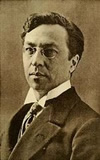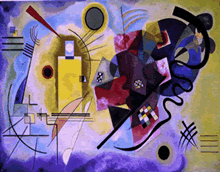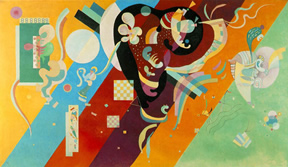
arts
Kandinsky Better Artist Than Lawyer?
 Who knows. Wassily Kandinsky might have been a fantastic lawyer, but let’s be glad he chose instead to be a pioneering abstact painter. The world is a better place for it, and he got a famous chair named after himself.
Who knows. Wassily Kandinsky might have been a fantastic lawyer, but let’s be glad he chose instead to be a pioneering abstact painter. The world is a better place for it, and he got a famous chair named after himself.
Born in Russia in 1866, Kandinsky had a promising career as a lawyer and was even on the law school faculty at Moscow University. One look at Monet’s Haystacks changed all that. It’s said that he hated the painting at first because the artist had intentinally obscured the reality of his subject. Something must have changed his mind, because at the age of 30 he enrolled in the Academy of Fine Arts in Munich and the rest is abstract art history.
Munich and the rest is abstract art history.
Trips to Paris afforded him the opportunity to view Gaugin’s work and he soon was back in Moscow developing ideas about the power of pure color and creating nonrepresentational works. When the Russian government banned abstract painting, Kandinsky returned to Germany and joined the Bauhaus faculty. That’s where he met Marcel Breuer who designed the Model B3 chair that later came to be known as the Wassily chair (only because Breuer made a duplicate for Kandinsky). He taught at Bauhaus until the Nazis shut  it down in 1933, and then lived in France for the rest of his life.
it down in 1933, and then lived in France for the rest of his life.
It was during the Bauhaus years that Kandinsky was increasingly interested in geometrical elements in his painting and teaching. The circle, half-circle, lines, curves and angles all began to show up in this period of intense output.
Although he was isolated in Paris because abstract art had little to no recognition there at the time, Kandinsky continued to his geometric themes. The works suggested microscopic organisms, and the paintings of his later years focus on striking a spiritual chord, and works such as Composition IV and Composition VI are translations of epic myths in abstract form.
 Unlike the abstract art luminaries of the 50s, Jackson Pollock and Mark Rothko, Kandinsky never abandoned reference points to the visitible world. In fact, he did not think there was anything abstract about his art. He preferred the description “concrete art” because it had solid forms that confronted the viewer.
Unlike the abstract art luminaries of the 50s, Jackson Pollock and Mark Rothko, Kandinsky never abandoned reference points to the visitible world. In fact, he did not think there was anything abstract about his art. He preferred the description “concrete art” because it had solid forms that confronted the viewer.
One thing is certain -- his work had a lasting impressions on the many abstract artists who followed. The best way to enjoy his work is to study it closely and let it reveal itself as you make a connection. In other words, take your time, and your patience will be rewarded with greater meaning.
Jay Harrison is a graphic designer and writer whose work can be seen at DesignConcept. He's written a mystery novel, which therefore makes him a pre-published author.
© 2006-2013 ConceptDesign, Inc. Terms of Use
BoomSpeak - For babyboomers - by babyboomers.